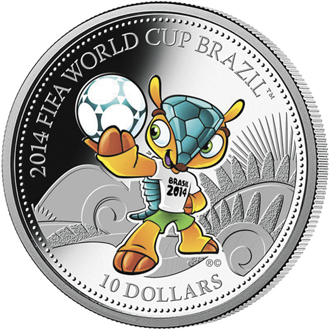As the world settles down from World Cup fever, coin collectors will have plenty of souvenirs to remember the 2014 games.
FIFA – the sanctioning body for the event – recognizing the success of commemorative coins for events such as the Olympic Games, created its own official numismatic program back in 2004.
In recent years, the company MDM (Münzhandelsgesellschaft Deutsche Münze) has been responsible for the development, promotion and roll-out of the official international commemorative coin program for the World Cup.
The coins offered by MDM include gold and silver commemorative coins from 40 different countries.
Understandably, many of the coins come from Germany, winner of the 2014 Cup. However most of the coins were created and struck before the competition started.
One numismatic item, created much later, pays tribute to the final game, between Germany and Argentina.
The coin, issued in gold and silver versions, shows the victorious German team with their arms raised in triumph. Below is the score of the championship game: Germany 1 Argentina 0.
The obverse of both coins shows the German coat of arms and the date 2014.
More information is available at www.mdm.de/wir-sind-weltmeister-silber-gold, although the content is in German.
With a program that extensive, this article can only look at a handful of the more interesting issued.
France brought out a selection of gold and silver coins, but the highlights of the offering may be the most interesting of all: a pair of curved coins.
The coins, struck with one side concave and the other convex, similar to the recently-issued Baseball Hall of Fame coins from the United States Mint. The convex side shows an image of the cup, surrounded by tropical scenes representing the host country. The concave side represents Maracana Stadium seen from above, with a soccer ball in the centre. Although rules require euro-issuing nations to have a common reverse design for circulating coins, that requirement is waived for non-circulating legal tender, allowing the issuing nation to have distinctive designs on both sides.
The gold coin has a value of 200 euros, while the silver coin has a value of 10 euros.
Similar designs are used for smaller gold coins which are of a conventional, flat shape.
At the same time, Banco Central do Brazil prepared the host country coin issues in January, with copper-nickel, silver and gold commemorative coins.
The gold coin, a 10 reais offering, shows the trophy on one side, and a ball in a net on the other. The most famous constellation viewable from the southern hemisphere, the Southern Cross, is also shown.
There are also two five-reais silver coins, one listing all 12 locations where games were played, with names of the cities and images representing each one. The second silver coin shows the games mascot on the obverse, and a player kicking a ball on the reverse.
Netherlands, often called the best team to never win a World Cup, managed a third place in 2014. While the nation did not issue a legal tender coin for the event, it did produce a striking medal. The medal shows Netherlands’ striker Robin van Persie’s famous swan-dive goal, for the match against Spain early in the tournament.
Chosen as an iconic image for the team, the medal shows van Persie diving forward to head the ball into the Spanish goal. The medal was produced by the Royal Dutch Mint and launched immediately after the team made it into the semifinals. More than 80 per cent of the mintage of 6,000 was ordered in just a few days, and the medal quickly sold out before the July 13 distribution started.
Argentina, which placed second, issued its World Cup coin in 2013. The five-pesos silver coin showed a group of players embracing, with the date of every World Cup tournament since the first one in 1930 on a banner around the edge. The reverse has the Argentina national emblem: a sunburst above a pair of hands clasping a pole crowned with a cap of liberty. Prior to the games it was offered for sale through the Royal Canadian Mint as part of a subscription series.
Although Canada didn’t get past the qualifying stage, the Royal Canadian Mint came out with two coins for the event. Designed by Greg Banning, the first coin shows a young player, with a maple leaf and cheering crowd in the background. A second, colourized cupro-nickel 25-cent coin was also issued. That coin has a large image of an adult player with three children playing, shown below. It was designed by Steve Hepburn, who included a map of Canada as one of the dark patches on the ball.

